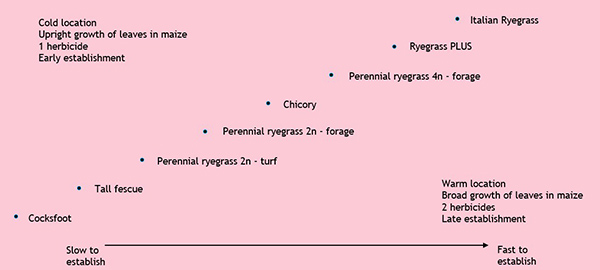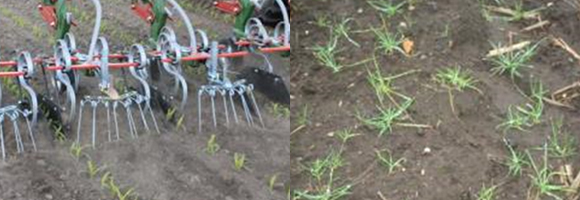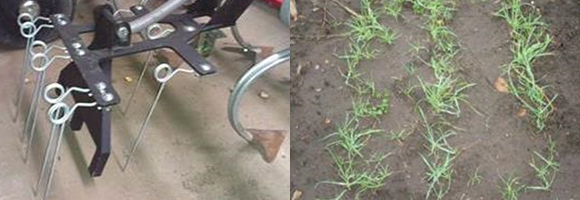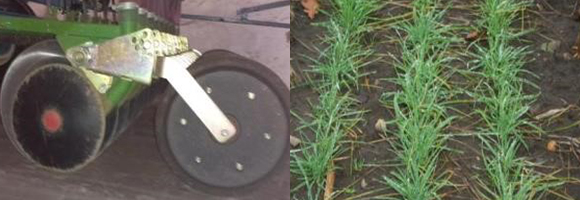How to benefit from your catch crops in maize
Growing a catch crop of grass within a field of maize offers farmers several benefits, such as retaining more nitrogen for the following crop, improving soil structure and reducing erosion.
10/02/2020
If you want to succeed with catch crops in maize you have to take several things into account. The balance between too much and too little is subtle. If you are able to establish the catch crop well, without competing with the maize, you get the following benefits from your catch crop:
- Less leaching of nitrogen and other nutrients
- Build-up of organic matter in the soil
- Better soil with less erosion
To get the right balance between the maize and the catch crop you should consider:
- Soil type – is it warm and sandy or cold clay?
- Speed of establishment – fast as Italian ryegrass or slow as tall fescue?
- Maize growth – are the leaves upright or broad?
- Weed control – how much is necessary?
- Sowing technique – widespread or row sown?
Soil type and climate plays a role
If you are located on a sandy and warm soil type the maize normally grows well and fast. In this case you should either establish the catch crop very early in the season or use fast establishing grasses.
On the contrary, if you are in a colder location where maize sometimes stops growing for a time because it is too cold, then you should establish the catch crop later in the season or use slow establishing grasses.
The graphic below shows which species to use depending on your location, the conditions and the growth of the grass.

Sowing technique affects results
Different sowing techniques can be applied, but be aware that they affect the end result. Trials show that in the worst case only 12 % of the catch crop germinates, compared to 45 % germination when done correct.
Also, with a poorer sowing technique such as broadcasting, it takes approximately one week more for the catch crop to germinate and establish. During that week the maize will have grown a lot - especially in warm conditions. The pictures below show three different sowing methods and the results.
Broadcast when row cultivated
Germination: 12%

Row sown without depth control and subsequent packing
Germination: 27%

Row sown with disc with depth adjustment and subsequent packing
Germination:45 %

Cocksfoot - a good choice for undersowing in maize
The growth habit of cocksfoot is perfect as companion to maize. It grows relatively slowly in the phase of establishment and with its tolerance to shade, drought and low competiveness, it will thrive well in the rows beneath the maize canopy. While cocksfoot establish slowly and develop a strong and comprehensive root and shoot system in the bottom of your field, you can concentrate on your maize.
Immediately after you have cropped your maize and you expose cocksfoot to more sunny conditions, it will take advantage of the favorable conditions. More sun and no competitiveness against water and nutrients will give cocksfoot a huge advantages and it will start to use its well-developed roots and shoot system and within short time it will close its canopy leaving no open spots to be seen. With its dense canopy and deep root system, it will not only retain many nutrients, which is released for the next crop, when it slowly decomposes, but it will also prevent soil erosion and create a strong soil cover for heavy traffic.
Using cocksfoot you:
- Do not have to fear a decrease in maize yield as to competiveness by another crop.
- Will experience a better soil structure as to comprehensive root development which will favor next crop
- Save costs for nutrients and experience a more nutrient rich soil as nutrients is retained by roots and leaf material and not leached.
Cocksfoot as a cover crop will not only benefit many agricultural aspects, but it will also be a sustainable solution as it decreases leaching of important nutrients into the soil and prevent soil erosion.
It is a good idea to use a mixture for undersowing in maize. This way you will benefit from the features of multiple species and a mixture also allows for better adjustment to the specific condition.
For further advice, please contact your local DLF representative or send us an e-mail at dlf@dlf.com.
